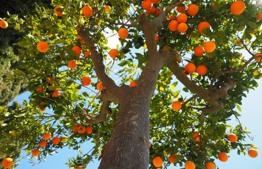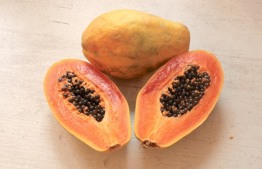Orlah, Chapter 4: Saplings exempt from and subject to orlah laws

Are trees planted as a living fence subject to orlah, and if not in which cases? What about self-seeding trees that sprout up on their own?
- Planting trees as a living fence or for ornamental purposes
- From the verse "and you plant any tree for food" (Vayikra 19:23), the Talmud Yerushalmi induces (Orlah 1:1): "[Trees] intended for food are obligated; [but those planted] for a fence, for the branches, or for the trees, are exempt." From here we see that if a person plants a tree for a purpose other than eating its fruits, such as a living fence, these trees are exempt from orlah laws, and the fruit may be eaten within the first three years. This heter (permit) applies with two provisos:
- It needs to be apparent that the planting of the trees is for this other purpose. For instance, if planting to create a living fence, the trees need to be planted in close proximity to one another. In this way it is clear for all to see that the trees were planted to form a fence.[1]
- The trees need to be planted for that defined purpose alone (even if one is aware that the plant bears fruit). However, if the purpose of planting the trees was both for the fence and for the fruit, the trees would still be subject to orlah The test as to the true intent of planting the trees is as follows: if the one planting the trees would do so even if the trees did not bear fruit, the fruit will be permitted. If not, then the purpose includes the fruit as well, in which case they would be subject to orlah.[2]
- Trees that bear fruit, but whose fruit is generally not eaten (so it is uncertain whether they are considered "fruit trees")—are nevertheless subject to orlah That is, of course, unless they are planted for a different purpose (a fence, etc., as mentioned above).[3] Nevertheless, it is possible to be lenient and to exempt these trees from orlah when planting the trees both for a defined purpose and for the fruit. For instance, when planting a pitanga tree as a living fence, since the trees are generally not cultivated for the fruit, it is possible to be lenient.[4]
- Also when there is a doubt whether the plant is considered a tree or a vegetable, it is possible to be lenient, as in the above case. For instance, when planting a passionfruit vine as a living fence, when the secondary purpose is its fruit, it is possible to eat the fruit within the first three years. This is true even according to those who are stringent and consider the plant a tree (see Chapter 3, Section 10).
- Dwarf trees planted for ornamental purposes and for their fruit: It is forbidden to eat the fruit of these trees during the orlah This is because they are planted both for their beauty and for the fruit, so they do not fall under the category of "planting a fence." However, if they were planted only for their beauty, then they are exempt from orlah.[5]
- Fruit trees whose fruit are used for medicinal purposes only[6] or for cosmetics (such as jojoba trees) are exempt from orlah
- Planting trees on the public’s behalf and self-seeding trees
- A fruit tree planted in the public sphere (reshut harabim)[7] and trees planted on private property (reshut hayachid) for the public's benefit are nevertheless subject to orlah.[8]
A self-seeding tree that sprouted on its own, if growing in private property is subject to orlah.[9] However, if such a fruit tree sprouted in a public place or on ownerless property, it is exempt from orlah. This is true provided that it is not profitable to cultivate its fruit
[1] Shulchan Aruch, YD §294:23; see also the Chazon Ish, Dinei Orlah §13, who holds that the need for a heker (for it being apparent) is biblically mandated. In contrast, the Minchat Chinuch, Mitzvah 246:2, holds that the heker is only rabbinic.
[2] Chazon Ish, Dinei Orlah §11.
[3] We are more lenient with such trees, since most do not consider it a fruit tree. For this reason, there needs to be an expressed intent for the tree to be planted to eat the fruit. Only in these cases are its fruit subject to orla. See Yerushalmi, Orlah 1:1 .For an explanation of the terms rimin and benot hadas, see Yedid Nefesh.
[4] Rabbi Yigal Kaminetsky,"Orlah vis-à-vis a living fence," HaTorah VeHa'aretz V (5760), pp. 104–109; see also Rabbi Yehuda Amichay, "Cultivating orlah pomegranates for ornamental purposes," Emunat Itecha 65 (5766), pp. 46–54.
[5] Yerushalmi, Orlah 1:1. On whether etrog trees are subject to orlah; Penei Moshe and Bi'ur HaGra. Rabbi Akiva Eiger on Shulchan Aruch §294:23. See Rabbi Azriel Ariel, "Orlah in date palms planted for ornamental purposes,"HaTorah VeHa'aretz V (5760), pp. 112–118.
[6] Radbaz I §499, §44; Chiddushei Rabbi Akiva Eiger on Shuchan Aruch, ibid. In this case there is no need for a heker like in the case of one planting a fence. This is because it is not a standard fruit tree that is being planted for a purpose other than using its fruit; rather, it is the general practice to use this tree for these purposes.
[7] Shulchan Aruch, YD §294:26.
[9] Shulchan Aruch, YD §294:27; see also the Shach (§35), who explains that in the private domain, such trees self-seed due to human involvement when working the land.




